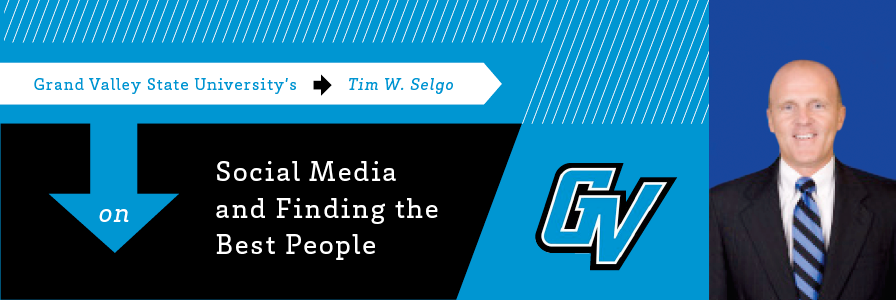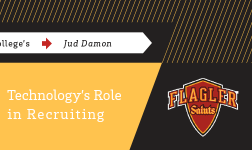 Tim W. Selgo – Grand Valley State University
Tim W. Selgo – Grand Valley State University 
Athletic Director
Tim W. Selgo is the Director of Athletics at Grand Valley State and enters his 18th year at the institution. Under Selgo’s leadership, Grand Valley State has finished among the top two in the Learfield Sports/NACDA Directors’ Cup standings for 12 consecutive years, including eight straight titles (2003-04 to 2010-11). In addition, GVSU has won 15 straight Great Lakes Intercollegiate Athletic Conference Presidents’ Cup titles as the top athletic program in the 16-team GLIAC. The Lakers’ 20 all-time Presidents’ Cup titles top all GLIAC institutions. Grand Valley State, which won 45 GLIAC titles prior to Selgo’s arrival, has won 139 GLIAC titles since Selgo was appointed Athletic Director in 1996.
Ryan Matthews, Winthrop’s Managing Editor, chatted recently with Tim about being nationally competitive, the use of social media, and finding and surrounding yourself with the best people.
What is one challenge that you’ve overcome at Grand Valley State University and one future challenge you see you’d like to surmount?
I think the biggest challenge we overcame during my almost 18 years here was to be nationally competitive. We first had to become competitive within our conference, the GLIAC, and then we had to develop the confidence that we could compete nationally. We had never won an NCAA Regional Championship at GVSU until our volleyball team did it in 2000. Then in 2002, our football team won our first ever national championship and we have won a total of 14 since.
A future challenge for us to surmount will be in the fund raising area. Both fund raising for facilities improvements (which are never ending) and annual fund raising. Our school is a very young school. We have only been in existence 52 years. Therefore, we do not have any “old” money. Our challenge is to engage as many of our alumni as we can to connect them with our program in every way, certainly with financial gifts to the program. As a public institution, only approximately 15% of our institution’s funding comes from the state appropriations today. Therefore, we have to think and operate more like a private school, which certainly means alumni engagement and private fund raising.
What aspect of your tenure at Grand Valley are you most proud of?
I am proud of the people we have had in our department during my time here. It is the key to success in anything and certainly college athletics. We have had throughout our coaching staff, as well as our administrative and support staff, hard-working people that care about kids first and know their stuff. When you mix that with a great school like Grand Valley, it is a formula for success. And it isn’t just the competitive success that I am proud of. Our student-athletes have consistently graduated at a higher rate than the student body and we consistently have between 55-60% of our student-athletes achieve a 3.0 GPA or better every semester. I am proud of our student-athletes success academically and athletically and that starts with having good leaders as coaches.
In addition, I am very proud of the fact that our student-athletes have represented our institution with class. As is the case with all college kids, they aren’t all perfect angels all the time, but by-and-large I am appreciative of the outstanding character that our student-athletes have exhibited over the years as well.
What has most surprised you during your tenure?
It doesn’t seem like such a surprise anymore, but the newspaper becoming irrelevant in the sports world today would have been unthinkable just 10-12 years ago. For most of my life the whole goal was to gain attention for your teams in the local paper and now there is no such thing. That technology has changed how we work isn’t as much of a surprise as it is perhaps a little shocking how much it has changed our operations and the speed at which it changed things.
But for someone like me who couldn’t wait to read the sports page every day for most of my life, and now I never read news in print anymore, it is certainly something I would not have predicted when I became A.D. here in 1996.
What’s your best advice for a new or hopeful AD?
There is nothing magic about success in college athletics. Surround yourself with the best people possible, provide the best resources for them possible, and then stay out of their way to let them make mistakes, grow, and develop. Patience with people is something which has been lost in college athletics, certainly at the Division I level. It takes YEARS to get really good at anything in life, including college athletics. That takes patience and thick skin for the A.D. when things don’t go right, and that often happens in college athletics. 18-22 year olds are NOT going to be perfect. But if you have hired the best people possible in your department, you have to be able to wade through the tough times and keep working hard to find solutions to your problems.
As an athletic administrator you are a problem solver. The BEST way to solve problems in college athletics is to surround yourself with the best people possible. One last point on that: search all avenues for talent. Outstanding coaches and administrators can come from ANY level, whether it be high school, community colleges, NAIA, D-III, or D-I assistants. You must keep an open mind and not limit yourself in finding the best talent possible for your programs. We have had some unbelievably successful people here come from each of those backgrounds.
How has technology impacted the planning and the execution of goals for Grand Valley State University?
As stated earlier, technological changes have been immense in our operations. Just like in most walks of life, technology has helped us do our jobs better. Technology has provided the means for better communication, which is always a good thing. It has allowed us to remain connected with everyone in our department when we are out of the office, which we often are in college athletics. Even a seemingly small thing like getting lightning alerts as text messages has helped us make playing in inclement weather safer for everyone involved.
Certainly social media has changed how we seek more supporters for our programs. The great thing about social media and the internet is that they allow more constituents to be more connected with our programs than ever before. It also changes how we interact with them and again, allows for greater effectiveness in our communications with them.




